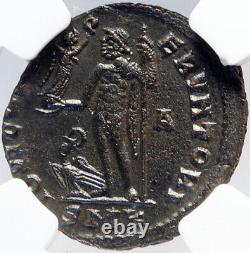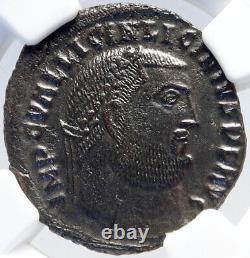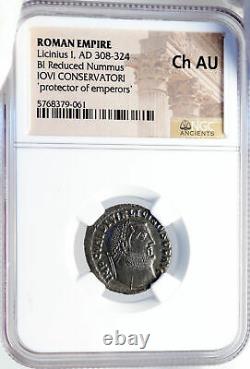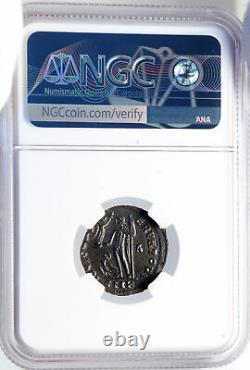
- Homepage
- Certification
- Coin Id
- Composition
- Grade
- Ruler
- Antoninus Pius (52)
- Augustus (141)
- Caracalla (53)
- Constantine I (57)
- Constantine Ii (29)
- Domitian (58)
- Gallienus (37)
- Gordian Iii (62)
- Hadrian (100)
- Marcus Aurelius (68)
- Nero (113)
- Nerva (31)
- Philip I (66)
- Septimius Severus (35)
- Severus Alexander (69)
- Theodosius Ii (32)
- Tiberius (69)
- Trajan (97)
- Trajan Decius (28)
- Vespasian (76)
- Other (1599)
- Year-mint-denom
LICINIUS I Authentic Ancient 313AD Cyzicus Roman Coin JUPITER EAGLE NGC i82899






Bronze Follis / Nummus 21mm Cyzicus mint, struck circa 313-315 A. Reference: RIC VII 4; Sear 15218.
Ch AU 5768379-061 IMP C VAL LICIN LICINIVS P F AVG, laureate head right. IOVI CONSERVATORI, Jupiter standing left holding Victory on globe and scepter; eagle at foot left, A in right field; mintmark SMK in exergue.
Jupiter, called Zeus by the Greeks. Jupiter was originally an elemental divinity, and his name signifies the father or lord of heaven, being a contraction of Diovis pater, or Diespiter. Being the lord of heaven, he was worshipped as the god of rain, storms, thunder, and lightning, whence he had the epithets of Pluvius, Fulgurator, Tonitrualis, Tonans, and Fulminator. As the pebble or flint stone was regarded as the symbol of lightning, Jupiter was frequently represented with such a stone in his hand instead of a thunderbolt. In concluding a treaty, the Romans took the sacred symbols of Jupiter, viz. The sceptre and flint stone, together with some grass from his temple, and the oath taken on such an occasion was expressed by per Jovem Lapidem jurare. In consequence of his possessing such powers over the elements, and especially of his always having the thunderbolt at his command, he was regarded as the highest and most powerful among the gods. Hence he is called the Best and Most High (Optimus Maximus). His temple at Rome stood on the lofty hill of the Capitol, whence he derived the surnames of Capitolinus and Tarpeius. He was regarded as the special protector of Rome. As such he was worshipped by the consuls on entering upon their office ; and the triumph of a victorious general was a solemn procession to his temple.He therefore bore the surnames of Imperator, Victor, Invictus, Stator, Opihdus, Feretrius, Praedator, Triumphator, and the like. Under all these surnames he had temples or statues at Rome ; and 2 temples, viz.
Those of Jupiter Stator and of Jupiter Feretrius, were believed to have been built in the time of Romulus. Under the name of Jupiter Capitolinus, he presided over the great Roman games ; and under the name of Jupiter Latialis or Latiaris, over the Feriae Latinae.
Jupiter, according to the belief of the Romans, determined the course of all human affairs. He foresaw the future, and the events happening in it were the results of his will. He revealed the future to man through signs in the heavens and the flight of birds, which are hence called the messengers of Jupiter, while the god himself is designated as Prodigialis, that is, the sender of prodigies.For the same reason the god was invoked at the beginning of every undertaking, whether sacred or profane, together with Janus, who blessed the beginning itself. Jupiter was further regarded as the guardian of law, and as the protector of justice and virtue. Hence Fides was his companion on the Capitol, along with Victoria ; and hence a traitor to his country, and persons guilty of perjury, were thrown down from the Tarpeian rock. As Jupiter was the lord of heaven, and consequently the prince of light, the white colour was sacred to him, white animals were sacrificed to him, his chariot was believed to be drawn by 4 white horses, his priests wore white caps, and the consuls were attired in white when they offered sacrifices in the Capitol the day they entered on their office. The worship of Jupiter at Rome was under the special care of the Flamen Dialis, who was the highest in rank of all the flamens.
The Romans, in their representations of the god, adopted the type of the Greek Zeus. Licinius I Latin: Gaius Valerius Licinianus Licinius Augustus ; c. 263-325 was a Roman emperor from 308 to 324. For most of his reign he was the colleague and rival of Constantine I, with whom he co-authored the Edict of Milan that granted official toleration to Christians in the Roman Empire. He was finally defeated at the Battle of Chrysopolis, before being executed on the orders of Constantine I.
Sculptural portraits of Licinius (left) and his rival Constantine I (right). Born to a Dacian peasant family in Moesia Superior, Licinius accompanied his close childhood friend, the future emperor Galerius, on the Persian expedition in 298. He was trusted enough by Galerius that in 307 he was sent as an envoy to Maxentius in Italy to attempt to reach some agreement about the latter's illegitimate political position. Galerius then trusted the eastern provinces to Licinius when he went to deal with Maxentius personally after the death of Flavius Valerius Severus. Upon his return to the east Galerius elevated Licinius to the rank of Augustus in the West on November 11, 308. He received as his immediate command the provinces of Illyricum, Thrace and Pannonia. In 310 he took command of the war against the Sarmatians, inflicting a severe defeat on them and emerging victorious. On the death of Galerius in May 311, Licinius entered into an agreement with Maximinus II (Daia) to share the eastern provinces between them. By this point, not only was Licinius the official Augustus of the west but he also possessed part of the eastern provinces as well, as the Hellespont and the Bosporus became the dividing line, with Licinius taking the European provinces and Maximinus taking the Asian. An alliance between Maximinus and Maxentius forced the two remaining emperors to enter into a formal agreement with each other. So in March 313 Licinius married Flavia Julia Constantia, half-sister of Constantine I, at Mediolanum (now Milan); they had a son, Licinius the Younger, in 315.The redaction of the edict as reproduced by Lactantius - who follows the text affixed by Licinius in Nicomedia on June 14 313, after Maximinus' defeat - uses a neutral language, expressing a will to propitiate "any Divinity whatsoever in the seat of the heavens". Daia in the meantime decided to attack Licinius. Leaving Syria with 70,000 men, he reached Bithyniaa, although harsh weather he encountered along the way had gravely weakened his army. In April 313, he crossed the Bosporus and went to Byzantium, which was held by Licinius' troops.
Undeterred, he took the town after an eleven-day siege. He moved to Heraclea, which he captured after a short siege, before moving his forces to the first posting station. With a much smaller body of men, possibly around 30,000, Licinius arrived at Adrianople while Daia was still besieging Heraclea.Before the decisive engagement, Licinius allegedly had a vision in which an angel recited him a generic prayer that could be adopted by all cults and which Licinius then repeated to his soldiers. On 30 April 313, the two armies clashed at the Battle of Tzirallum, and in the ensuing battle Daia's forces were crushed. Ridding himself of the imperial purple and dressing like a slave, Daia fled to Nicomedia. Believing he still had a chance to come out victorious, Daia attempted to stop the advance of Licinius at the Cilician Gates by establishing fortifications there. Unfortunately for Daia, Licinius' army succeeded in breaking through, forcing Daia to retreat to Tarsus where Licinius continued to press him on land and sea.
The war between them only ended with Daia's death in August 313. Given that Constantine had already crushed his rival Maxentius in 312, the two men decided to divide the Roman world between them.
As a result of this settlement, Licinius became sole Augustus in the East, while his brother-in-law, Constantine, was supreme in the West. Licinius immediately rushed to the east to deal with another threat, this time from the Persian Sassanids.
In 314, a civil war erupted between Licinius and Constantine, in which Constantine used the pretext that Licinius was harbouring Senecio, whom Constantine accused of plotting to overthrow him. Constantine prevailed at the Battle of Cibalae in Pannonia (October 8, 314). Although the situation was temporarily settled, with both men sharing the consulship in 315, it was but a lull in the storm. The next year a new war erupted, when Licinius named Valerius Valens co-emperor, only for Licinius to suffer a humiliating defeat on the plain of Mardia (also known as Campus Ardiensis) in Thrace.
The emperors were reconciled after these two battles and Licinius had his co-emperor Valens killed. Over the next ten years, the two imperial colleagues maintained an uneasy truce. Licinius kept himself busy with a campaign against the Sarmatians in 318, but temperatures rose again in 321 when Constantine pursued some Sarmatians, who had been ravaging some territory in his realm, across the Danube into what was technically Licinius's territory. When he repeated this with another invasion, this time by the Goths who were pillaging Thrace, Licinius complained that Constantine had broken the treaty between them. Constantine wasted no time going on the offensive. Then in 324, Constantine, tempted by the "advanced age and unpopular vices" of his colleague, again declared war against him and having defeated his army of 170,000 men at the Battle of Adrianople (July 3, 324), succeeded in shutting him up within the walls of Byzantium. The defeat of the superior fleet of Licinius in the Battle of the Hellespont by Crispus, Constantine's eldest son and Caesar, compelled his withdrawal to Bithynia, where a last stand was made; the Battle of Chrysopolis, near Chalcedon (September 18), resulted in Licinius' final submission. While Licinius' co-emperor Sextus Martinianus was killed, Licinius himself was spared due to the pleas of his wife, Constantine's sister and interned at Thessalonica. The next year, Constantine had him hanged, accusing him of conspiring to raise troops among the barbarians. After defeating Daia, he had put to death Flavius Severianus, the son of the emperor Severus, as well as Candidianus, the son of Galerius. He also ordered the execution of the wife and daughter of the Emperor Diocletian, who had fled from the court of Licinius before being discovered at Thessalonica. As part of Constantine's attempts to decrease Licinius's popularity, he actively portrayed his brother-in-law as a pagan supporter. This was not the case; contemporary evidence tends to suggest that he was at least a committed supporter of Christians. He co-authored the Edict of Milan which ended the Great Persecution, and re-affirmed the rights of Christians in his half of the empire. He also added the Christian symbol to his armies, and attempted to regulate the affairs of the Church hierarchy just as Constantine and his successors were to do.His wife was a devout Christian. It is even a possibility that he converted. However, Eusebius of Caesarea, writing under the rule of Constantine, charges him with expelling Christians from the Palace and ordering military sacrifice, as well as interfering with the Church's internal procedures and organization.
According to Eusebius, this turned what appeared to be a committed Christian into a man who feigned sympathy for the sect but who eventually exposed his true bloodthirsty pagan nature, only to be stopped by the virtuous Constantine. Finally, on Licinius's death, his memory was branded with infamy; his statues were thrown down; and by edict, all his laws and judicial proceedings during his reign were abolished. World-renowned expert numismatist, enthusiast, author and dealer in authentic ancient Greek, ancient Roman, ancient Byzantine, world coins & more. Ilya Zlobin is an independent individual who has a passion for coin collecting, research and understanding the importance of the historical context and significance all coins and objects represent. Send me a message about this and I can update your invoice should you want this method.
Getting your order to you, quickly and securely is a top priority and is taken seriously here. Great care is taken in packaging and mailing every item securely and quickly.
What is a certificate of authenticity and what guarantees do you give that the item is authentic? You will be very happy with what you get with the COA; a professional presentation of the coin, with all of the relevant information and a picture of the coin you saw in the listing. Additionally, the coin is inside it's own protective coin flip (holder), with a 2x2 inch description of the coin matching the individual number on the COA. Whether your goal is to collect or give the item as a gift, coins presented like this could be more prized and valued higher than items that were not given such care and attention to.When should I leave feedback? Please don't leave any negative feedbacks, as it happens sometimes that people rush to leave feedback before letting sufficient time for their order to arrive.
The matter of fact is that any issues can be resolved, as reputation is most important to me. My goal is to provide superior products and quality of service. How and where do I learn more about collecting ancient coins? Visit the Guide on How to Use My Store.
For on an overview about using my store, with additional information and links to all other parts of my store which may include educational information on topics you are looking for. This item is in the category "Coins & Paper Money\Coins: Ancient\Roman: Imperial (27 BC-476 AD)".The seller is "highrating_lowprice" and is located in this country: US. This item can be shipped worldwide.
- Certification Number: 5768379-061
- Certification: NGC
- Grade: Ch AU
- Ruler: Licinius I
- Denomination: Denomination_in_description
- Year: Year_in_description

